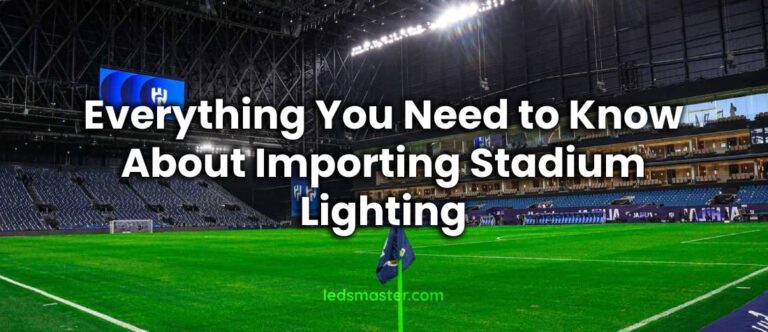
Discover how to import top-quality stadium lights and locate the perfect supplier with our expert guide. We cover essential factors like performance, efficiency, and durability to help you make informed choices. Explore our resources for valuable insights on selecting reliable suppliers and ensuring your stadium lighting investment meets your needs effectively.
Get your complimentary lighting design today
Welcome to our comprehensive resource on sourcing superior stadium lighting and identifying the perfect supplier to illuminate your sports facilities effectively and economically. Selecting the ideal stadium lights involves considerations beyond mere brightness; it entails optimizing visibility, reducing operational expenses, and promoting environmental sustainability. Whether you’re managing a venue, designing architectural plans, or spearheading a development project, the task of choosing the right lighting solution and dependable supplier can seem daunting. Our in-depth guidance provides the expertise and insights necessary to navigate this process with confidence, ensuring your stadiums dazzle with efficiency and clarity for athletes and spectators alike.
Stadium lighting plays a pivotal role that extends far beyond mere illumination. It influences the atmosphere, enhances visibility for players and spectators alike, and significantly impacts operational costs. As stadiums worldwide seek to enhance their facilities with cutting-edge technology, the demand for efficient and effective lighting solutions has never been higher. This article delves into the world of stadium lighting imports, focusing particularly on the transformative power of LED lights in modern sports arenas.
Table of Contents
ToggleNavigating collaboration with stadium lighting manufacturers involves a strategic approach to ensure seamless integration and optimal performance of lighting systems in sports venues. Begin by initiating clear communication and providing a detailed project brief outlining specific requirements such as lighting levels, energy efficiency goals, and regulatory standards. Engage in technical consultations to leverage the manufacturer’s expertise in stadium lighting design, and work together to develop a comprehensive proposal that includes layout plans, fixture specifications, and energy calculations tailored to your stadium’s unique layout and needs.
Customization plays a crucial role in selecting fixtures that enhance visibility, minimize glare, and support the overall spectator experience. Negotiate contracts that align with budgetary constraints and project timelines, ensuring clarity on warranties, delivery schedules, and additional services such as installation support and training. Throughout the project, maintain open lines of communication to address any challenges and modifications promptly, coordinating efforts with stakeholders to ensure smooth implementation and integration of the lighting system into the stadium infrastructure.
Conduct rigorous quality assurance checks and testing before installation to verify compliance with safety regulations and performance standards. Provide comprehensive training for stadium staff on operating and maintaining the lighting system, and establish a support plan with the manufacturer for ongoing technical assistance and maintenance needs. Foster a long-term partnership by sharing feedback on system performance and exploring opportunities for future upgrades and advancements in stadium lighting technology. By following these steps, stakeholders can navigate collaboration with lighting manufacturers effectively, achieving optimal lighting solutions that enhance both performance and spectator experience in sports venues.

Negotiating the import of light fixtures involves a methodical approach aimed at securing cost-effective, high-quality products while ensuring smooth logistics and compliance with regulatory standards. To begin, it’s crucial to define clear requirements and specifications for the light fixtures, considering factors such as design preferences, technical specifications, and regulatory certifications necessary for your market. This clarity enables effective communication with potential suppliers and helps streamline the selection process.
Next, thorough research into reputable suppliers is essential. Look for manufacturers or distributors with a solid track record in producing and exporting light fixtures that meet international quality standards. Assess their experience, customer reviews, and their capability to handle the complexities of international logistics and customs procedures smoothly. This groundwork lays the foundation for informed decision-making during negotiations.
Initiating the negotiation process involves requesting detailed quotations (RFQs) from selected suppliers. These RFQs should outline your specific requirements, including quantities needed, delivery timelines, payment terms, and any additional services required. Negotiation discussions should focus on achieving favorable terms such as competitive pricing based on volume discounts, flexible payment terms, and assurances regarding product quality and compliance with regulatory requirements.
Quality assurance is paramount when importing light fixtures. Ensure the supplier has robust quality control measures in place and can provide samples for evaluation before finalizing the order. Verify adherence to safety standards, environmental regulations, and any import restrictions applicable in your region. Additionally, clarify logistics arrangements, including shipping methods, lead times, insurance coverage, and responsibilities for packaging and customs clearance.
Once negotiations are successful, finalize the agreement by signing a comprehensive contract that delineates all agreed-upon terms and conditions. The contract should cover aspects such as product specifications, pricing, delivery schedules, warranties, and dispute resolution mechanisms. Regular communication with the supplier post-contract helps monitor progress, address any issues promptly, and ensure timely delivery of the light fixtures.
Finding the best lighting manufacturer for stadium projects involves a systematic approach to ensure you choose a reliable partner that meets technical and operational needs. Start by clearly defining project requirements, including lighting levels, energy efficiency goals, and regulatory standards. Research manufacturers with proven expertise in stadium lighting, assessing their track record, past projects, and client testimonials to gauge reliability and performance. Look for quality products that adhere to industry standards and certifications, ensuring safety and optimal performance. A manufacturer’s ability to customize solutions to fit your stadium’s layout and requirements is crucial, along with their commitment to providing comprehensive support services, including technical assistance and after-sales support.
Compare pricing structures while considering long-term value through factors like energy savings and maintenance costs. Excellent customer service and responsiveness are key indicators of a manufacturer’s reliability, as is their commitment to sustainability and ethical business practices. Seek recommendations and visit showrooms or request product demonstrations to gain firsthand insights into a manufacturer’s capabilities and the suitability of their lighting solutions for your stadium project. By conducting thorough research and due diligence, you can identify the best lighting manufacturer that aligns with your project’s goals and ensures optimal performance and efficiency in stadium lighting.
Stadium lighting stands as a vital component that goes beyond its practical role in illuminating sports arenas. It sets the ambiance, enhances visibility crucial for both players and spectators, and significantly impacts operational costs. As stadiums worldwide strive to integrate advanced technologies, the demand for efficient lighting solutions, particularly LED technology, has surged. This article has explored the realm of stadium lighting imports, highlighting the transformative impact of LED lights in modern sports venues. From navigating collaboration with manufacturers to negotiating the import of light fixtures, stakeholders are equipped with strategic insights to foster successful partnerships and implement cutting-edge lighting solutions that elevate both performance and spectator experience in sports arenas.